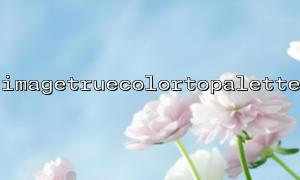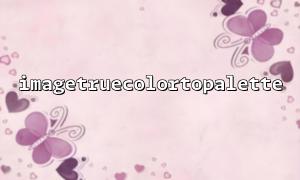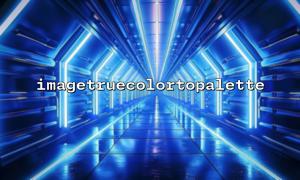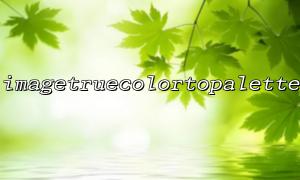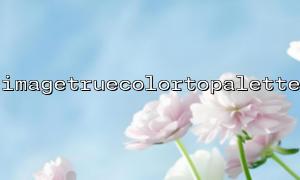The basic syntax of the imagetruecolortopalette() function is as follows:
<span><span><span class="hljs-keyword">bool</span></span><span> </span><span><span class="hljs-title function_ invoke__">imagetruecolortopalette</span></span><span> ( resource </span><span><span class="hljs-variable">$image</span></span><span>, </span><span><span class="hljs-keyword">bool</span></span><span> </span><span><span class="hljs-variable">$dither</span></span><span>, </span><span><span class="hljs-keyword">int</span></span><span> </span><span><span class="hljs-variable">$colors</span></span><span> )
</span></span>$image: The target image resource, usually created by functions such as imagecreatefromjpeg() or imagecreatefrompng().
$dither: Whether to enable dithering. Dithering helps maintain image details and smooth transitions when reducing the number of colors.
$colors: Specifies the maximum number of colors allowed in the palette. This value is an integer representing the number of colors in the palette.
<span><span><span class="hljs-variable">$image</span></span><span> = </span><span><span class="hljs-title function_ invoke__">imagecreatefromjpeg</span></span><span>(</span><span><span class="hljs-string">'example.jpg'</span></span><span>);
</span><span><span class="hljs-title function_ invoke__">imagetruecolortopalette</span></span><span>(</span><span><span class="hljs-variable">$image</span></span><span>, </span><span><span class="hljs-literal">true</span></span><span>, </span><span><span class="hljs-number">256</span></span><span>);
</span></span>The above code converts the example.jpg image from true color to a palette-based image with up to 256 colors.
The color count parameter (i.e., $colors) in imagetruecolortopalette() directly determines the maximum number of colors that can be used after conversion. Proper control of this parameter can reduce file size while maintaining reasonable image quality.
Choosing the Appropriate Number of Colors
In many cases, selecting the right number of colors is crucial. For example, 256 colors may suffice for simple images or icons, while more color-rich images might require a higher number. Experimentation is often necessary to find the optimal color count.
<span><span><span class="hljs-title function_ invoke__">imagetruecolortopalette</span></span><span>(</span><span><span class="hljs-variable">$image</span></span><span>, </span><span><span class="hljs-literal">true</span></span><span>, </span><span><span class="hljs-number">16</span></span><span>); </span><span><span class="hljs-comment">// 16-color palette</span></span><span>
</span></span>Setting the color count too low may cause loss of image details and gradients, resulting in a flat or distorted appearance. Therefore, adjust the color number to match the complexity of the image content.
Enhancing Image Quality Using Dithering
The dither parameter enables or disables dithering. Dithering is a common technique that introduces noise into color-limited images to simulate richer gradients. For palette images with low color counts, enabling dithering usually produces a more natural effect.
<span><span><span class="hljs-title function_ invoke__">imagetruecolortopalette</span></span><span>(</span><span><span class="hljs-variable">$image</span></span><span>, </span><span><span class="hljs-literal">true</span></span><span>, </span><span><span class="hljs-number">16</span></span><span>); </span><span><span class="hljs-comment">// Enable dithering with 16 colors</span></span><span>
</span></span>Without dithering, gradients in the image may appear harsh, causing noticeable color banding.
Setting a Reasonable Upper Limit for Colors
Balancing file size and color quality requires choosing an appropriate maximum color count based on actual needs. For example, when generating web thumbnails, fewer colors often maintain clarity while reducing file size. Using too many colors increases file size and processing time, possibly exceeding practical requirements.
Combining with Other Functions
You can use imagetruecolortopalette() together with other PHP image processing functions to further optimize results. For instance, applying filters like contrast or brightness adjustment before conversion can make the main colors stand out more, aiding palette optimization.
<span><span><span class="hljs-title function_ invoke__">imagefilter</span></span><span>(</span><span><span class="hljs-variable">$image</span></span><span>, IMG_FILTER_CONTRAST, -</span><span><span class="hljs-number">50</span></span><span>); </span><span><span class="hljs-comment">// Enhance contrast</span></span><span>
</span></span>
<span><span><span class="hljs-title function_ invoke__">imagetruecolortopalette</span></span><span>(</span><span><span class="hljs-variable">$image</span></span><span>, </span><span><span class="hljs-literal">true</span></span><span>, </span><span><span class="hljs-number">128</span></span><span>); </span><span><span class="hljs-comment">// Use a 128-color palette</span></span><span>
</span></span>Adjusting the color distribution with filters helps better control the conversion results.
Creating Small Icons or Images
When generating small icons or images, a limited number of colors is usually sufficient because palette-based images can significantly reduce storage space. For example, a 16x16 icon often needs only 256 colors. If the image is more complex, increase the color count accordingly, but generally do not exceed 256 colors.
Color Compression and Optimization
Reducing the number of colors is an effective method for storing large quantities of images or improving website loading speed. For images with simpler color schemes, such as logos or graphics, using fewer colors can greatly reduce file size.
Creating Vintage or Retro Style Images
The imagetruecolortopalette() function is ideal for simulating old-style images. Using fewer colors can create a “low resolution” or “pixelated” effect, which suits certain design styles very well.
